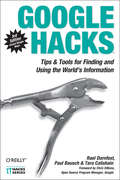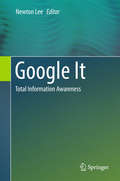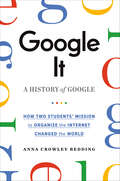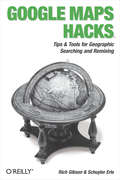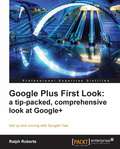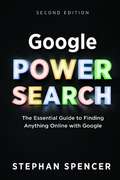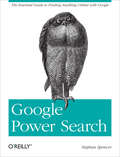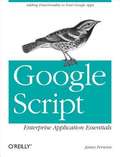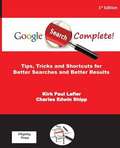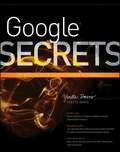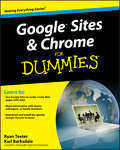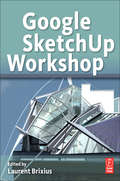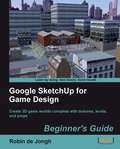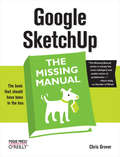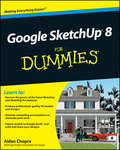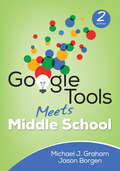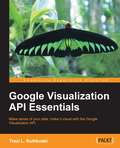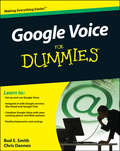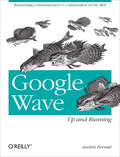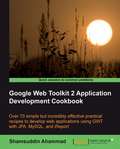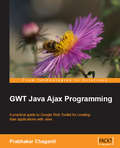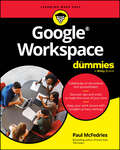- Table View
- List View
Google Hacks: Tips & Tools for Finding and Using the World's Information
by Rael Dornfest Paul Bausch Tara CalishainEveryone knows that Google lets you search billions of web pages. But few people realize that Google also gives you hundreds of cool ways to organize and play with information. Since we released the last edition of this bestselling book, Google has added many new features and services to its expanding universe: Google Earth, Google Talk, Google Maps, Google Blog Search, Video Search, Music Search, Google Base, Google Reader, and Google Desktop among them. We've found ways to get these new services to do even more. The expanded third edition of Google Hacks is a brand-new and infinitely more useful book for this powerful search engine. You'll not only find dozens of hacks for the new Google services, but plenty of updated tips, tricks and scripts for hacking the old ones. Now you can make a Google Earth movie, visualize your web site traffic with Google Analytics, post pictures to your blog with Picasa, or access Gmail in your favorite email client. Industrial strength and real-world tested, this new collection enables you to mine a ton of information within Google's reach. And have a lot of fun while doing it: Search Google over IM with a Google Talk botBuild a customized Google Map and add it to your own web siteCover your searching tracks and take back your browsing privacyTurn any Google query into an RSS feed that you can monitor in Google Reader or the newsreader of your choiceKeep tabs on blogs in new, useful waysTurn Gmail into an external hard drive for Windows, Mac, or LinuxBeef up your web pages with search, ads, news feeds, and moreProgram Google with the Google API and language of your choice For those of you concerned about Google as an emerging Big Brother, this new edition also offers advice and concrete tips for protecting your privacy. Get into the world of Google and bend it to your will!
Google It
by Newton LeeFrom Google search to self-driving cars to human longevity, is Alphabet creating a neoteric Garden of Eden or Bentham's Panopticon? Will King Solomon's challenge supersede the Turing test for artificial intelligence? Can transhumanism mitigate existential threats to humankind? These are some of the overarching questions in this book, which explores the impact of information awareness on humanity starting from the Book of Genesis to the Royal Library of Alexandria in the 3rd century BC to the modern day of Google Search, IBM Watson, and Wolfram|Alpha. The book also covers Search Engine Optimization, Google AdWords, Google Maps, Google Local Search, and what every business leader must know about digital transformation. "Search is curiosity, and that will never be done," said Google's first female engineer and Yahoo's sixth CEO Marissa Mayer. The truth is out there; we just need to know how to Google it!
Google It: A History of Google
by Anna Crowley ReddingThink. Invent. Organize. Share. Don't be evil. And change the world.Larry Page and Sergey Brin started out as two Stanford college students with a wild idea: They were going to organize the world's information. From that one deceptively simple goal, they created one of the most influential and innovative companies in the world. The word “google” has even entered our vocabulary as a verb. Now, find out the true history of Google—from its humble beginnings as a thesis project made out of “borrowed” hardware and discount toys through its revolution of the world's relationship with technology to a brief glimpse of where they might take us next. In Google It, award-winning investigative reporter Anna Crowley Redding shares an inspiring story of innovation, personal and intellectual bravery, and most importantly, of shooting for the moon in order to change the world.
Google Maps Hacks: Foreword by Jens & Lars Rasmussen, Google Maps Tech Leads (Hacks)
by Schuyler Erle Rich GibsonWant to find every pizza place within a 15-mile radius? Where the dog parks are in a new town? The most central meeting place for your class, club or group of friends? The cheapest gas stations on a day-to-day basis? The location of convicted sex offenders in an area to which you may be considering moving? The applications, serendipitous and serious, seem to be infinite, as developers find ever more creative ways to add to and customize the satellite images and underlying API of Google Maps.Written by Schuyler Erle and Rich Gibson, authors of the popular Mapping Hacks, Google Maps Hacks shares dozens of tricks for combining the capabilities of Google Maps with your own datasets. Such diverse information as apartment listings, crime reporting or flight routes can be integrated with Google's satellite imagery in creative ways, to yield new and useful applications.The authors begin with a complete introduction to the "standard" features of Google Maps. The adventure continues with 60 useful and interesting mapping projects that demonstrate ways developers have added their own features to the maps. After that's given you ideas of your own, you learn to apply the techniques and tools to add your own data to customize and manipulate Google Maps. Even Google seems to be tacitly blessing what might be seen as unauthorized use, but maybe they just know a good thing when they see one.With the tricks and techniques you'll learn from Google Maps Hacks, you'll be able to adapt Google's satellite map feature to create interactive maps for personal and commercial applications for businesses ranging from real estate to package delivery to home services, transportation and more. Includes a foreword by Google Maps tech leads, Jens and Lars Rasmussen.
Google Maps JavaScript API Cookbook
by Balkan Uraz Alper DincerGoogle Maps API Cookbook follows a fast-paced, high-level, structured cookbook approach, with minimal theory and an abundance of practical, real-world examples explained in a thorough yet concise manner to help you learn quickly and efficiently.Google Maps API Cookbook is for developers who wish to learn how to do anything from adding a simple embedded map to a website to developing complex GIS applications with the Google Maps JavaScript API. It is targeted at JavaScript developers who know how to get by but who are also seeking the immediacy of recipe-based advice.
Google Plus First Look: a tip-packed, comprehensive look at Google+
by Ralph RobertsThrough over 100 books, mostly computer-related, the author has mastered a fun but information packed style that gives you exactly what you want -- up to speed on Plus with minimal effort and maximum results. Google+ or Plus (the terms are interchangeable) was written for everyone. This book mirrors that concept and is written for everyone -- from us techheads (early adopters) to delightful old Aunt Mable and the rest of the Thursday Night Bridge Club. Because social networking exists for all people and we are all people -- all of us are plusses on Plus.
Google Power Search: The Essential Guide To Finding Anything Online With Google
by Stephan M. SpencerWhat would happen to your productivity if your Web searches always quickly returned the most relevant results? Over the course of a year, you could recover days of time wasted on inefficient searches and irrelevant results; and by mastering Google's search refinement operators and lesser-known features, hard-to-find information such as market research and competitive intelligence would become accessible to you. This book will show you how to find what you need quickly and accurately.
Google Power Search: The Essential Guide to Finding Anything Online with Google (Oreilly And Associate Ser.)
by Stephan SpencerBehind Google's deceptively simple interface is immense power for both market and competitive research—if you know how to use it well. Sure, basic searches are easy, but complex searches require specialized skills. This concise book takes you through the full range of Google's powerful search-refinement features, so you can quickly find the specific information you need. Learn techniques ranging from simple Boolean logic to URL parameters and other advanced tools, and see how they're applied to real-world market research examples.Incorporate advanced search operators such as filetype:, intitle:, daterange:, and others into your queriesUse Google filtering tools, including Search Within Results, Similar Pages, and SafeSearch, among othersExplore the breadth of Google through auxiliary search services like Google News, Google Books, Google Blog Search, and Google ScholarAcquire advanced Google skills that result in more effective search engine optimization (SEO)
Google Script: Enterprise Application Essentials
by James FerreiraHow can you extend Google Apps to fit your organization's needs? This concise guide shows you how to use Google Scripts, the JavaScript-based language that provides a complete web-based development platform--with no downloads, configuration, or compiling required. You'll learn how to add functionality to Gmail, spreadsheets, and other Google services, or build data-driven apps that run from a spreadsheet, in a browser window, or within a Google Site. If you have some Java experience, getting started with Google Scripts is easy. Through code examples and step-by-step instructions, you'll learn how to build applications that authenticate users, display custom data from a spreadsheet, send emails, and many more tasks. Learn Google Script's built-in debugger, script manager, and other features Create a user interface as a pop-up window, a web page, or a Google Sites gadget Use data objects and CSS to build effective product pages Automatically generate web forms from key values you specify in your Google Docs Create a database UI that works as a mobile app and Google Site gadget Use Google Docs and Gmail to create a document revision workflow
Google Search Complete: Tips, Tricks and Shortcuts for Better Searches and Better Results
by Kirk Paul Lafler; Charles Edwin ShippFilled with useful tips, techniques and shortcuts, Google Search Complete! provides insights on how Google search works and illustrates numerous examples to find websites, people, businesses, articles of interest, reference works, information tools, directories, PDFs, images, current news stories, user and professional groups, and other content.
Google Secrets
by Yvette DavisBecome a Google guru with these effective tips, tricks, and techniques Sure, you use Google. But do you really use Google-and everything it has to offer-in the most effective way possible? Wish you could just sit down with a Google expert who would show you how to take your Google savviness to the next level? With Google Secrets, you can! Tech expert Jerri Ledford reveals the ins, outs, and little-known facts about Google to show you how to sharpen your skills so you can get more done, more efficiently. You may already be familiar with Google's most popular applications, but this indispensable guide puts your knowledge to the test with insider tips, valuable insights, and unbeatable advice on Gmail, Google Voice, Google Sketchup, Google Analytics, and dozens more. Explores the dozens of Google applications that help you stay in touch, collaborate more effectively, and locate all the information you need to accomplish almost any task Builds on your already-savvy set of Google skills and takes your smarts to the next level with little-known secrets, unique tips and tricks, and helpful hints Reveals the powerful capabilities of the entire spectrum of Google applications, such as Gmail, Google Docs, Picasa, Google Buzz, Google Maps, and much more If you demand more than just the basics, then Google Secrets is the book you've been waiting for!
Google Sites & Chrome For Dummies
by Karl Barksdale Ryan TeeterCurious about Google Sites and how team collaboration Web sites can help you share documents online from various locations? Curious about Google's new Chrome browser? Google Sites & Chrome For Dummies has what you want to know! Today, Google is so much more than another word for "search. " Google Sites & Chrome For Dummies shows you how to create great collaborative Web sites with Google Sites and surf the Web with the super-fast Google Chrome browser. Find out how they work with other Google Apps, too. You'll learn to: Take advantage of free hosting, free tools, and a simple, straightforward interface with Google Sites Set up a Google account or Google Apps account Create wiki sites that let coworkers collaborate on projects or keep family members up to date Use Google gadgets to keep track of projects, manage calendars and documents, or display photos Integrate documents, spreadsheets, presentations, and other Google Apps into your site Work with Contact List, Google Talk, and Google Chat, and handle e-mail with Gmail Download and install the speedy Google Chrome browser Install browser plug-ins, enable offline access to Google Docs, and manage misbehaving tabs You'll even find instructions and examples to help you plan sites for personal and business use, plus a sample college course site. With advice from Google Sites & Chrome For Dummies, you can make collaboration easy and have the high-speed Web at your fingertips.
Google SketchUp Cookbook: Practical Recipes and Essential Techniques
by Bonnie RoskesAs the first book for intermediate and advanced users of Google SketchUp, this Cookbook goes beyond the basics to explore the complex features and tools that design professionals use. You'll get numerous step-by-step tutorials for solving common (and not so common) design problems, with detailed color graphics to guide your way, and discussions that explain additional ways to complete a task. Google SketchUp Cookbook will help you:Use SketchUp more efficiently by taking advantage of components and groupsLearn new techniques for using Follow Me, Intersect, and constraintsGo beyond simple textures with tools such as texture positioning and Photo MatchCreate animations and walkthroughs, and explore design scenarios by using layers and scenesLearn how to use styles to customize your presentationsCombine SketchUp with the 3D Warehouse and Google EarthGoogle SketchUp Cookbook is ideal for architects, engineers, interior designers, product designers, woodworkers, and other professionals and hobbyists who want to work more efficiently and achieve true mastery of this amazing tool.
Google SketchUp Workshop: Modeling, Visualizing, And Illustrating
by Laurent BrixiusDiscover the secrets of the Google SketchUp with the 16 real-world professional-level projects including parks, structures, concept art, and illustration. Google SketchUp Workshop includes all the wide variety of projects that SketchUp can be used for-architectural visualization, landscape design, video game and film conception, and more. SketchUp masters in every field will get you up to speed in this agile and intuitive software and then show you the real uses with through projects in architecture, engineering, and design.
Google SketchUp for Game Design: Beginner's Guide
by Robin De JonghThe book takes a clear, step-by-step approach to building a complete game level using SketchUp with many props and textures. This book is designed for anyone who wants to create entire 3D worlds in freely available game engines such as Unity 3D, CryEngine, Ogre, Panda3D, Unreal Engine, and Blender Game Engine. It also targets all those who wish to create new levels and assets to sell in game asset stores or use in visualization or animation.
Google SketchUp: The Missing Manual (Missing Manual)
by Chris GroverIf you want to learn to create 3-D models using Google SketchUp, this Missing Manual is the ideal place to start. Filled with step-by-step tutorials, this entertaining, reader-friendly guide will have you creating detailed 3-D objects, including building plans, furniture, landscaping plans -- even characters for computer games -- in no time. Google SketchUp: The Missing Manual offers a hands-on tour of the program, with crystal-clear instructions for using every feature and lots of real-world examples to help you pick up the practical skills you need. Learn to use the basic tools, build and animate models, and place your objects in Google Earth. With this book, you will:Learn your way around the SketchUp workspace, and explore the differences between working in 2-D and 3-DBuild simple 3-D shapes, save them as reusable components, and use SketchUp's Outliner to show or hide them as you workTackle a complicated model building with lots of detail, and discover timesaving tools for using many componentsAnimate the model by creating an interior walkthrough of your buildingDress up your model with realistic material shading and shadows, and place it in Google EarthIt's easy to get started. Just download the program from Google.com, and follow the instructions in this book. You'll become a SketchUp master in a jiffy.
Google Sketchup 7 For Dummies
by Aidan ChopraGoogle SketchUp is the exciting free software package that makes 3D available to everybody. Whether you need to build 3D models for work, or you've just always wanted to explore 3D modeling, Google SketchUp was made for you. Still, it does take a bit of understanding to get started, so turn to Google SketchUp 7 For Dummies. In classic For Dummies tradition, Google SketchUp 7 For Dummies gets right to the point so you can start creating 3D models right away. You'll learn to: Set up SketchUp, learn about edges and faces, use inferences and guides, and build your first model Establish a basic end-to-end workflow for creating and sharing models Model non-boxy objects like terrain, characters, bottles, and spheres Add details like stairs, gutters, and eaves Spruce up your models with styles and shadows to add effects, make objects pop, and enhance realism Use the LayOut function to draw with vector tools, add text and callouts, and print your work Design buildings and objects, export your models to other design programs or to Google Earth, and explore 3D animation On the book's companion Web site, you'll also find a bonus chapter and videos demonstrating more about what you can do with Google SketchUp. Google SketchUp 7 For Dummies also shows you what SketchUp can and can't do, and offers tips for solving common problems. Add a new dimension to your work today!
Google Tools Meets Middle School (Corwin Teaching Essentials)
by Michael J. Graham Jason M. BorgenBecome a master of 21st century learning for your students Google Apps and Chromebooks have become ubiquitous in classrooms, but how can you thoughtfully and seamlessly integrate these tools into day-to-day teaching to prepare your students for the jobs of the future? Filled with actionable instruction ideas, the newest edition of this bestselling book includes: Step-by-step tutorials on how to use the Google Apps for Education suite so students can create, collaborate, and share their work How each tool can impact student learning, promote 21st-century skills, and meet and exceed ISTE NETs, Common Core, and other standards New and updated classroom examples, teaching tips, and sample lessons to help you use these tools most effectively The exciting second edition will invigorate veteran teachers to implement new strategies while helping novice teachers get familiar with crucial technology components students need for success for high school and later in life. "Graham and Borgen have hit the nail on the head! They have compiled extensive resources to provide the teachers with a one-stop location to move technology integration forward in a school or district." Tim Landeck, Director, Technology Services Pajaro Valley Unified School District, Watsonville, CA "Given the fact that Google now dominates the edtech market, mastering the tools in the G Suite for Education is no longer a luxury but rather a necessity for 21st-century educators. The authors have written a comprehensive instructional work the covers the full range of Google tools -- from Gmail to Google Drive and beyond. Pedagogy, lesson ideas, and helpful tech tips round out a book that will surely be a must read for any forward-thinking educator." Dr. John Davenport, Middle School ELA and History Teacher Portola Valley School District, Portola Valley, CA
Google Tools Meets Middle School (Corwin Teaching Essentials)
by Michael J. Graham Jason M. BorgenBecome a master of 21st century learning for your students Google Apps and Chromebooks have become ubiquitous in classrooms, but how can you thoughtfully and seamlessly integrate these tools into day-to-day teaching to prepare your students for the jobs of the future? Filled with actionable instruction ideas, the newest edition of this bestselling book includes: Step-by-step tutorials on how to use the Google Apps for Education suite so students can create, collaborate, and share their work How each tool can impact student learning, promote 21st-century skills, and meet and exceed ISTE NETs, Common Core, and other standards New and updated classroom examples, teaching tips, and sample lessons to help you use these tools most effectively The exciting second edition will invigorate veteran teachers to implement new strategies while helping novice teachers get familiar with crucial technology components students need for success for high school and later in life. "Graham and Borgen have hit the nail on the head! They have compiled extensive resources to provide the teachers with a one-stop location to move technology integration forward in a school or district." Tim Landeck, Director, Technology Services Pajaro Valley Unified School District, Watsonville, CA "Given the fact that Google now dominates the edtech market, mastering the tools in the G Suite for Education is no longer a luxury but rather a necessity for 21st-century educators. The authors have written a comprehensive instructional work the covers the full range of Google tools -- from Gmail to Google Drive and beyond. Pedagogy, lesson ideas, and helpful tech tips round out a book that will surely be a must read for any forward-thinking educator." Dr. John Davenport, Middle School ELA and History Teacher Portola Valley School District, Portola Valley, CA
Google Visualization API Essentials
by Traci L. RuthkoskiThis book is a step-by-step tutorial full of diagrams, core concept explanations, best practice tips, and links to working book examples. This book will show you how create web-ready data visualizations using Google's infrastructure. Some HTML knowledge is the only requirement, although some JavaScript knowledge is also helpful.
Google Voice For Dummies
by Bud E. Smith Chris DannenSave time and money with Google's revolutionary new phone system Google Voice combines existing phone lines, e-mail, and Web access into one central communication channel. Tech industry watchers expect it to give Skype some serious competition, yet little information is available on this new Google service. Google Voice For Dummies is the first and only book on Google's breakthrough new offering and provides essential information for individuals and businesses who want to take advantage of this exciting new technology. Google Voice is expected to have a major impact on telephony and to offer major cost savings for individuals and businesses This guide focuses on an in-depth understanding of setting up and using Google Voice and how to integrate it with other Google services, including Gmail, Google Chat, and Google Talk Discusses managing Google Voice within organizations and examines key concerns for business, schools, government, and other kinds of organizations Explains how Google Voice connects with the many phone options currently available and how to move toward an optimized and inexpensive, yet flexible and powerful phone environment The book is supported by news and updates on www. gvDaily. com, the leading Google Voice question and answer site created by authors Bud E. Smith and Chris Dannen Google Voice For Dummies supplies much-needed information on this free and exciting technology that the New York Times has called revolutionary.
Google Wave: Up and Running
by Andres FerrateCatch Google Wave, the revolutionary Internet protocol and web service that lets you communicate and collaborate in realtime. With this book, you'll understand how Google Wave integrates email, instant messaging (IM), wiki, and social networking functionality into a powerful and extensible platform. You'll also learn how to use its features, customize its functions, and build sophisticated extensions with Google Wave's open APIs and network protocol.Written for everyone -- from non-techies to ninja coders -- Google Wave: Up and Running provides a complete tour of this complex platform. You'll quickly work with the Google Wave Client, the app that lets users participate and collaborate on waves, and learn how to augment waves with gadgets and robots. In the process, you'll appreciate why Google Wave offers a great new model for online communication and collaboration.Become thoroughly familiar with Google Wave, including its structure, key concepts, and terminologyGet a hands-on introduction to the APIs and resources that will help you develop on this platformLearn how to use Google Wave's APIs to develop your own gadgets and robots, and to embed waves on web pagesDiscover through use cases how Google Wave offers consumers a distinct advantage over current communication and collaboration technologies
Google Web Toolkit 2 Application Development Cookbook
by Shamsuddin AhammadThe recipes in this book are in a straightforward and easy to follow format.The range of topics covered in this book will bring out the forward-thinking Java developer in you.If you want to build AJAX web applications with GWT then this book is for you.Developers with prior programming experience of Java development and object-oriented programming will find this book very useful.
Google Web Toolkit GWT Java AJAX Programming
by Prabhakar ChagantiEach chapter covers a series of practical tasks, showing how to achieve a particular useful result and then learn how it works so that you can apply your knowledge to your own unique situation. Readers will need experience writing non-trivial applications using Java. Experience with developing web interfaces is useful, but knowledge of JavaScript and DHTML is not requiredâ ¦ GWT takes care of that!
Google Workspace For Dummies
by Paul McFedriesEasy advice for getting the most out of Google Workspace for school, work, or personal use Google Workspace For Dummies is here to show you the tips and tricks for upping your productivity with Google's cloud-based software suite. This book includes jargon-free instructions on using Gmail, Calendar, Docs, Sheets, Drive, Chat, and Meet. You'll learn about the AI features, updated security, compatibility with other apps, picture-in-picture capability for video meetings, and beyond. Plus, you'll get info on Google's Forms and Notes feature that makes it simple to gather and share data and stay up-to-date with your team. It's easier than ever to collaborate securely in the cloud, thanks to this Dummies book. Learn how to collaborate with colleagues in real time using the programs that come with Google Workspace Create and edit contacts, and set up video meetings Work on slides, spreadsheets, and documents Discover tips and tricks to increase productivity and keep your work secure Google Workspace For Dummies is a must for business users and workers who use Google applications on the job. Casual users and students, you'll love it, too.
